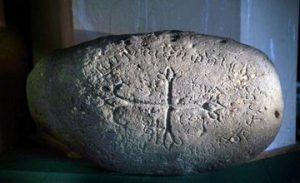 In 1892, not far from Pishpek (modern Bishkek), Russian explorer Nikolai Pantusov discovered a medieval Christian cemetery with thousands of stone steles, tombstones, and monuments.
In 1892, not far from Pishpek (modern Bishkek), Russian explorer Nikolai Pantusov discovered a medieval Christian cemetery with thousands of stone steles, tombstones, and monuments.
The find itself wasn’t so surprising. Starting from ancient times, the inhabitants of the vast territories of Central Asia have professed Christianity.
The strangest artifact was a stone or, as it is called by scholars, Kayrak, which has Armenian inscriptions reading the name of one Bishop Hovhannes, who died in 772 of the old Armenian calendar (in 1323).
The Kayrak was sent to St. Petersburg, where another outstanding scientist and Armenologist, Nikolas Marr, studied it. He discovered that the Armenian letters were written in the old style of the alphabet.

The scientist suggested that perhaps the Armenian colony had been located in the neighborhood of China in the territory of modern Kyrgyzstan and had been isolated from the Armenian Highland long enough for the old Armenian to stay unchanged for several centuries. Later, the Assyrian writings on the Kayrak gave a start to numerous debates.
After the split of the western church, most of the excommunicated Christians fled to east. They were called Nestorians, the adherents of the teachings of Archbishop Nestorius, who was excommunicated in 431.
For several centuries, they have preached and spread Christianity in Persia, India, Central Asia, and China. They used the Assyrian alphabet, which later became the basis of the alphabets of many nomadic peoples of Asia: Uighurs, Mongols, Manchus.
However, no evidence of Nestorian presence in the Armenian territory has been ever discovered. On the contrary, it has been always asserted that “these pagans” had not even shown up there.
So, the Kayrak with the Armenian-Assyrian inscriptions might shed some light on the previously unknown pages of Armenian colonial history on the distant borders of Asian states.

In 2011, during the filming of the documentary film “Armenians – a Journey to China” directed by Ruben Gini, a new stage of research began. The film crew tried to catch the trail of the famous artifact.
As it turned out, it was not so simple. Kayrak was covered by Marr in the year of 1894. He claimed that the stone had been moved to facilities of the Imperial Archaeological Commission, which cut short the trace of the artifact.
According to Ruben Gini, there was almost no hope that the stone survived the tumultuous events of the 20th century, including the Russian Revolution, two world wars, and the disintegration of the USSR.
However, they continued their search. The only data the crew had was the exact location of the discovery of the Kayrak near modern Bishkek, and a small picture-impression made by Marr himself.
During the filming, the group visited Kyrgyzstan, where it intended to film another disappeared Armenian monument, the Monastery of the Armenian Brothers, which is most likely located on the shore of Lake Issyk-Kul near the Chinese border.

“We met the vice-president of the Academy of Sciences of Kyrgyzstan, Vladimir Ploskikh, who had been searching for the legendary monastery for more than ten years,” Ruben Gini said. “During the meeting, I also tried to gather more information about the Kayrak.
Unfortunately, no one knew about the whereabouts of the artifact. A young employee of the Institute, Dmitry Luzhanskiy, connected us with the Curator of the Oriental Department of the State Hermitage Museum, which has received the materials of the Imperial Archaeological Commission after 1919.
We told him about the problem. After some time, when I almost forgot about Kayrak, we received a letter claiming that the stone was contained in the Hermitage storehouse.
It was exciting news! I asked for a photo to make sure that the stone is indeed the one found by Pantusov more than a century ago. It was the right stone.
We altered the shooting schedule to be able to visit St. Petersburg. With the permission of the director of Hermitage, Mikhail Piotrovsky, we were allowed to take the first modern photo and film of the Pishpek Kayrak.
Kayrak is a huge boulder, which cannot be easily moved. For the first time in many years, the artifact saw daylight again. It is kept in a dimly lit room, but Armenian letters stand out clearly.
The word “yepiskopos” looks especially bright. The stone is framed by the Assyrian translation of the inscription: “Jesus Christ, God. Armenian Bishop Hovhannes. This inscription was made in 772 of the old Armenian calendar.”
The find was a real gift. After all, the film’s theme was closely connected with the annals of the Armenian colonies in the vicinity of China and in China itself. It is more than necessary to show the material, which is considered unique by many scientists dealing with the history of interethnic relations in Central Asia.”
Further studies of Kayrak might bring a better understanding of how the contacts between Europe and Asia developed in the early stages of history, in which the Armenians played an important role. After all, they knew the way to China perfectly and often acted as guides for the first European travelers and traders.
by : Tigran Mirzoyan



6 thoughts on “Mysterious Artifact from the Border of China”
Armenians in Cina